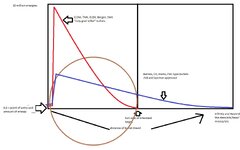doc holiday13
WKR
To start this conversation, i'm no JVB or Spomer, but there is definitely something going on with bigger calibers that doesn't happen with smaller calibers. Full stop
I fully believe in the effectiveness of 223/5.56, 6mm, and 25 cal rounds. I used them and have taken deer with them and I continue to do it. Anecdotally though, I see waaay more destructiveness coming from 6.5mm+ calibers. This isn't just my annecdote either. Between myself and two friends we see over 100 deer killed every year(damage control permits). We pop deer out to 600yd. Even when using the "holy grail" 6mm bullets that are talked about here, we tend to see deer running upwards of 100yards and less meat blowout than deer dropped with the 6.5+ bullets. 6.5+ bullets tend to completely remove legs and generally are dropping deer like a light switch going from on to off. (these statements exclude head shots)
Wallop is a thing, but not in the way most understand it. Wallop is expressed in how a bullet sheds its energy. 2 identical weight and caliber bullets will wallop a deer differently based on construction type. Think 55g FMJ vs 55g V-MAX . The FMJ will likely pencil through and the Vmax will blow up with 5" of penetration. Now we can easy say bigger bullet at same velocity and same construction type is more energy downrange, thats physics. So, that said a 6mm bullet that doesn't exit and breaks into 5 pieces would in theory dump more energy than a 300 win mag monolith bullet(bullet tip barely expands to bullet diameter). I say "in theory" because we can only theorize 300 win energy imparted on target because bullet continued to fly and really only poked a 30 cal size hole.
I've drawn up a sweet graph on how we want our bullets to act and how JVB's bullets act.
The red line is obviously ideal right? Low energy energy at entry and after it penetrates it has a HUGE disruption causing damage and that energy and velocity will drop to zero as it approaches the backside of the target. We know this happens when there is no exit hole. I'm not saying that I consider it a bullet failure if the bullet exits.
Blue line might actually be a bit too generous because some people have found their monocore bullet in the offside hide, but the wound channel is basically same size as caliber of the bullet as opposed to multiple little wound channels
I fully believe in the effectiveness of 223/5.56, 6mm, and 25 cal rounds. I used them and have taken deer with them and I continue to do it. Anecdotally though, I see waaay more destructiveness coming from 6.5mm+ calibers. This isn't just my annecdote either. Between myself and two friends we see over 100 deer killed every year(damage control permits). We pop deer out to 600yd. Even when using the "holy grail" 6mm bullets that are talked about here, we tend to see deer running upwards of 100yards and less meat blowout than deer dropped with the 6.5+ bullets. 6.5+ bullets tend to completely remove legs and generally are dropping deer like a light switch going from on to off. (these statements exclude head shots)
Wallop is a thing, but not in the way most understand it. Wallop is expressed in how a bullet sheds its energy. 2 identical weight and caliber bullets will wallop a deer differently based on construction type. Think 55g FMJ vs 55g V-MAX . The FMJ will likely pencil through and the Vmax will blow up with 5" of penetration. Now we can easy say bigger bullet at same velocity and same construction type is more energy downrange, thats physics. So, that said a 6mm bullet that doesn't exit and breaks into 5 pieces would in theory dump more energy than a 300 win mag monolith bullet(bullet tip barely expands to bullet diameter). I say "in theory" because we can only theorize 300 win energy imparted on target because bullet continued to fly and really only poked a 30 cal size hole.
I've drawn up a sweet graph on how we want our bullets to act and how JVB's bullets act.
The red line is obviously ideal right? Low energy energy at entry and after it penetrates it has a HUGE disruption causing damage and that energy and velocity will drop to zero as it approaches the backside of the target. We know this happens when there is no exit hole. I'm not saying that I consider it a bullet failure if the bullet exits.
Blue line might actually be a bit too generous because some people have found their monocore bullet in the offside hide, but the wound channel is basically same size as caliber of the bullet as opposed to multiple little wound channels




